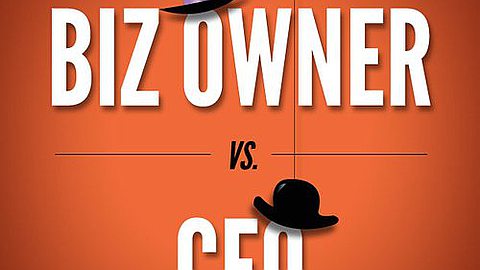The 25 Most Influential Business Management Books

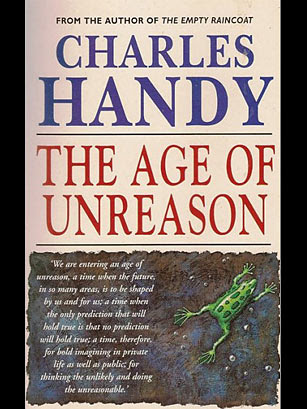 The Age of Unreason (1989), by Charles Handy
The Age of Unreason (1989), by Charles Handy
Handy's 1989 book made a powerful case for what might then have been called, without irony, outside-the-box business thinking. Handy, then a visiting professor at the London Business School, described dramatic social changes going on in everyday life and in the workplace. New technologies and the decrease of full-time positions, among other transformations, requires abandoning the established rules and experimenting with new ways of working with one another. Handy's book only grew in stature in the decades after its publication as the rise of the Internet, ubiquitous communication, increased outsourcing, and the explosion of social media proved his vision to be amazingly prescient.
 Built to Last: Successful Habits of Visionary Companies (1994), by Jim Collins and Jerry Porras
Built to Last: Successful Habits of Visionary Companies (1994), by Jim Collins and Jerry Porras
This landmark survey of 18 "visionary" companies attempts to suss out what made successful behemoths like Disney, 3M, and Sony stand out. Stanford business professor Jerry Porras and Good to Great author Jim Collins found that, contrary to popular belief, the companies that blow competitors out of the water aren't so much driven by sexy leaders or staunch focus. Instead, what they have in common is strong corporate culture. In other words, hire bright people and allow them to thrive. Seems like common sense, but in the late 90s the book raised eyebrows.
 Competing for the Future (1996), by Gary Hamel and C.K. Prahalad
Competing for the Future (1996), by Gary Hamel and C.K. Prahalad
Stating that their book "provides would-be revolutionaries with the tools and concepts they need to challenge the protectors of the past," Hamel and Prahalad argued for a much broader conception of business strategy — a redefinition that has since solidified into a received truth. They show that strategic planning must happen all the time, not just during discreet breaks from a company's regular business; that it must be emotional, meaningful, and purpose-driven, not just analytical; and that this impulse must be nurtured throughout an organization, not just among strategists and consultants. Among the key teachings is that executives need to actively nurture their company's "core competencies" to anticipate — and not merely adapt to — industry changes.
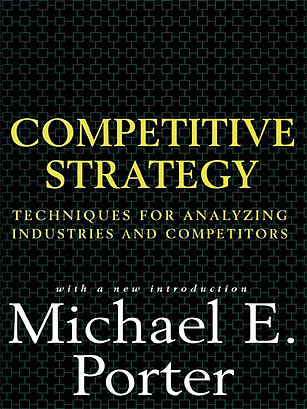 Competitive Strategy: Techniques for Analyzing Industries and Competitors (1980), by Michael E. Porter
Competitive Strategy: Techniques for Analyzing Industries and Competitors (1980), by Michael E. Porter
For three decades, Michael Porter's Competitive Strategy has been the starting point for managers wanting to maximize profitability within a competitive marketplace. The Harvard Business School professor's five basic competitive forces, which condense and simplify the complexity of industry competition, are as relevant today as they were in 1980. With step-by-step tools to help managers select new industries to enter, forecast how industries evolve, and recognize "market signals" from competitors, Porter breaks down the three generic competitive factors — cost, differentiation and focus — that are vital for helping managers conduct industry and competitor analysis.
 Emotional Intelligence (1995), by Daniel Goleman
Emotional Intelligence (1995), by Daniel Goleman
What factors are at play, asks the author, "when people of high IQ flounder and those of modest IQ do surprisingly well?" Those qualities, such as self-control, persistence and motivation, are known as emotional intelligence or EQ. Without them, writes Goleman, careers are often unnecessarily dashed on the rocks. There is hope, though: "Temperament is not destiny," he writes. The author explains how a higher EQ can be developed through psychological education. The compelling ideas the author introduces have since become a means of assessing and nurturing an employee's behavior and management skills.
 The E-Myth Revisited: Why Most Small Business Don't Work and What to Do about It (1985), by Michael E. Gerber
The E-Myth Revisited: Why Most Small Business Don't Work and What to Do about It (1985), by Michael E. Gerber
Gerber's small business management guide is often called an underground success, but its passionate following has grown far beyond the usual definition of a cult. The "E-Myth," or entrepreneurial myth, of the title refers to the common — and usually disastrous — assumption that a person who excels at the technical or operational work of a business will naturally succeed at running such a business. Gerber dispels the myth by showing that, in addition to being a technician, a successful business owner must be an effective manager (who excels at systematizing the company's profitable work) and entrepreneur (who has a vision for the company's future).
 The Essential Drucker (2001), by Peter Drucker
The Essential Drucker (2001), by Peter Drucker
Over a career that spanned nearly 60 years before he died in 2005 at age 95, Peter Drucker single-handedly invented the field of management theory. For most of the last half of the 20th century, he was the superstar CEO's go-to guru, counseling everyone from Alfred Sloan to Andy Grove. And not in the fuzzy-headed, inspirational, bromide-spouting guru sense you see today. Drucker had no time for discussing who moved your cheese, and his insights were distinctive for being simultaneously crystalline yet deeply contrarian — and, frequently, a generation ahead of their time. Just one example: He was talking about the rise and importance of "knowledge workers" in the 1970s, when the phrase was a good two decades from common parlance. With 30 books to choose from, it's probably best to start with The Essential Drucker, a potent 26-piece collection selected by Drucker himself in 2001 as a comprehensive representation of his life's work.
 The Fifth Discipline: The Art and Practice of the Learning Organization (1990), by Peter Senge
The Fifth Discipline: The Art and Practice of the Learning Organization (1990), by Peter Senge
Many a management manual is built around case studies and data analysis. But the epiphany that grew into this book came to Peter Senge one morning while meditating. Senge, who founded the Center for Organizational Learning at MIT's Sloan School of Management, developed five essential disciplines of a true "learning organization," which is one that continually improves (and stays competitive) by helping its members learn. The first four disciplines focus on developing individual focus, building a shared vision, and communicating as a team. But the heart of the book is the Fifth Discipline, called "systems thinking," which involves analyzing the organization's complex system of relationships and removing obstacles to true learning.
 First, Break All the Rules (1999), by Marcus Buckingham and Curt Coffman
First, Break All the Rules (1999), by Marcus Buckingham and Curt Coffman
First, Break All the Rules encourages managers to personalize and break away from traditional, one-size-fits-all leadership techniques. Gallup consultants Buckingham and Coffman pull responses from more than 80,000 interviews to determine that the best managers are "revolutionaries" who cast the right people for the right roles — and leave them to do their best work. Among the tome's other takeaways: Treat employees like individuals, set specific outcomes, but not the process, and focus on employee strengths instead of calling out weaknesses.
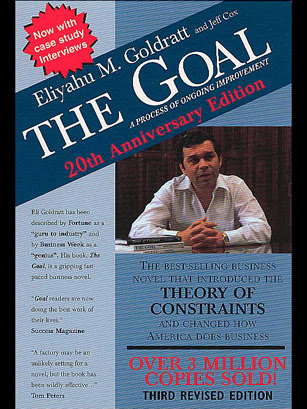 The Goal (1984), by Eliyahu Goldratt
The Goal (1984), by Eliyahu Goldratt
Eliyahu Goldratt's The Goal is unusual among business management books for at least two reasons. First, Goldratt wasn't a titan of industry, a b-school professor, or even a consultant, but rather a physicist. Second, The Goal is a novel. Centered on a production manager named Alex Rogo who has three months to turn around a deficient, unprofitable manufacturing plant, The Goal explains the "Theory of Constraints," which among other points incorporates the idiom, "A chain is only as strong as its weakest link;" and focuses on bottlenecks, the great hindrances to productivity. Rogo uses the Socratic method to help fix his marriage, then applies it to his plant crew, coming up with steps to solve the plant's problems. The Goal has been in print since 1984, and a revised third edition was released on the book's 20th anniversary. So does Rogo achieve his goal? You'll have to read it to find out.
 Good to Great: Why Some Companies Make the Leap ... and Others Don't (2001), by Jim Collins
Good to Great: Why Some Companies Make the Leap ... and Others Don't (2001), by Jim Collins
How does a company go from being merely successful to sustaining profits over long periods? That's the central question of Jim Collins' book, a deeply-researched analysis that starts with all 1,400 companies on the Fortune 500 since 1965 and narrows the list to 11 companies that sustained excellence over time — often by going against accepted industry wisdom. Companies like Fannie Mae (ahem), Gillette, Kroger and Wells Fargo have what Collins discovered to be seven characteristics that contributed to their success, including a culture of discipline, finding the right employees and harnessing technology in the most efficient ways possible.
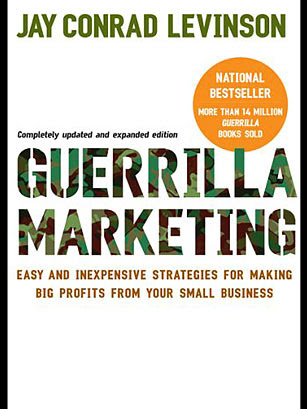 Guerilla Marketing (1984), by Jay Conrad Levinson
Guerilla Marketing (1984), by Jay Conrad Levinson
n the same way that guerilla warfare changed how people thought about war and conflict, Jay Conrad Levinson's concept of guerrilla marketing reshaped how small companies think about promoting themselves. Before Levinson coined the term in the 1980s, companies often relied upon huge, expensive marketing endeavors. Smaller companies struggled to compete on those terms, so Levinson argued for using brains over brawn. Don't hang a banner to advertise a sale; give away products on the street. Don't place expensive ads; pull a PR stunt for free publicity. Twenty-five years later, empires have been built using these ideas.
 How to Win Friends and Influence People (1936), by Dale Carnegie
How to Win Friends and Influence People (1936), by Dale Carnegie
The author described himself as a "simple country boy" from Missouri, and to be sure, some of the advice in his blockbuster bestseller is pure cornpone ("If you want to gather honey, don't kick over the beehive"). But Dale Carnegie was a wizard when it came to making the public like him. Besides buying more than 30 million copies worldwide of his Depression-era book, they broke down the doors of his educational programs, which also promised professional success and happiness. Carnegie's plain-spoken wisdom about how to advance career-wise still resonates with a sophisticated urban workforce. Perhaps that is because he was no hick when it came to understanding business behavior: "About 15 percent of one's financial success is due to one's technical knowledge and about 85 percent is due...to personality and the ability to lead people."
 The Human Side of Enterprise (1960), by Douglas McGregor
The Human Side of Enterprise (1960), by Douglas McGregor
Before Douglas McGregor's seminal work on management, employees were often presumed to be lazy and unmotivated. As a result, conventional wisdom held, management must goad workers into becoming productive cogs in the machine. McGregor revolutionized human resources thinking by positing two ways managers could view employees: Theory X assumes workers are inherently lazy; Theory Y assumes they are self-motivated. While not clearly on the side of Theory Y, McGregor seems to lean toward the idea that management should ultimately set the workplace conditions to allow people to not only do well at work, but to want to do well.
 The Innovator's Dilemma (1997), by Clayton Christensen
The Innovator's Dilemma (1997), by Clayton Christensen
Unlike most business books, The Innovator's Dilemma is about failure. Harvard Business School professor Clayton Christensen takes a look at why large, once successful companies with seemingly talented CEOs regularly falter or, worse, go bust. Christensen's take is that in business success does not breed success. In fact, it's the opposite. Large dominant companies often are blind to emerging technologies or changing market trends that will make their once-innovative products obsolete. The lesson: Adapt early and often, even if it costs you profits today.
 Leading Change (1996), by John P. Kotter
Leading Change (1996), by John P. Kotter
In business, change is perpetual and necessary. Companies that fail to adapt fail, period. So driving transformation is arguably the business leader's primary objective — and yet woefully few succeed. Kotter's 1996 book details an intuitive, eight-stage process, each illustrated with examples drawn from his extensive consulting experience, for implementing real and lasting organizational change. As important as the practical tips, however, is the powerful distinction Kotter draws between managing change and leading change. As Kotter vividly demonstrates, only the latter can keep a company a step ahead.
 On Becoming a Leader (1989), by Warren Bennis
On Becoming a Leader (1989), by Warren Bennis
Leadership guru Warren Bennis's guide to honing your inner leader tends to read more like a self-help book than a business tutorial. Bennis's now classic take on the leadership conundrum calls the dearth of effective leaders a "societal disease" characterized by shortsighted thinking and a lack of self-awareness. The proposed solution? Pointers include honing your "inner voice," cultivating a passion for what you do, and building trust among followers.
 Out of the Crisis (1982), by W. Edwards Deming
Out of the Crisis (1982), by W. Edwards Deming
This is the book that first articulated (without using the term) Total Quality Management, the now-ubiquitous idea that the quality of products and services, and their continuous improvement, is the responsibility of a broad range of corporate stakeholders, from managers and workers to suppliers and even customers. Deming is widely credited (along with Taiichi Ohno) with introducing systematic quality measurement and improvement techniques to Japanese manufacturing in the 1960s, and Out of the Crisis brought his revolutionary ideas to U.S. businesses. The 14 key management principles enumerated in the book directly contradicted many standard practices of the era — including production quotas, "zero defect" slogans, and management by inspection — and became a template for modern management techniques.
 My Years with General Motors (1964), by Alfred P. Sloan Jr.
My Years with General Motors (1964), by Alfred P. Sloan Jr.
The author, the CEO of GM from 1923-1946, was an industry titan who led the Detroit carmaker to become the largest corporation in the world. Publication of this forthright book was blocked for years by GM's lawyers, who feared its revelations about the inside-workings of the company would be used against it in litigation. Sloan's shrewd lessons about managing the automotive behemoth, from corporate structure to product development to finance, are still considered a business-school must-read. "A car for every purse and purpose," indeed.
 The One Minute Manager (1982), by Kenneth Blanchard and Spencer Johnson
The One Minute Manager (1982), by Kenneth Blanchard and Spencer Johnson
This slim volume, with its simple (critics argued, simple-minded) business homilies, immediately became a worldwide publishing phenomenon, and spent more than two years on the New York Times bestsellers list. In it, would-be effective managers are advised to "catch an employee doing something right," and to reinforce that good behavior with a One Minute Praising. Bad deeds are similarly to be pointed out and punished with a One Minute Reprimand. The authors themselves were accused of a bad deed by the Wall Street Journal — plagiarism, to be exact — which they denied. But by that time, the tiny tome was ubiquitous, having been distributed by FORTUNE 500 companies everywhere.
 Reengineering the Corporation: A Manifesto for Business Revolution (1993), by James Champy and Michael Hammer
Reengineering the Corporation: A Manifesto for Business Revolution (1993), by James Champy and Michael Hammer
Adam Smith's business dictums from the 1800s no longer apply. That's the thinking behind management consultants James Champy and Michael Hammer's 1994 bestseller. Rigid divisions of labor — which once sped up productivity in fledgling corporate America — was now driving the sluggishness and lack of creativity holding firms back, the authors contend. They advocate for a radical redesign of the way companies process and organize their business, including regrouping multiple jobs into one. No wonder the book is credited with inspiring corporate downsizing in the 1990s. In the digital age, its insights still ring true.
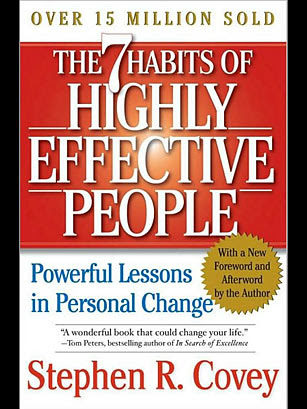 The 7 Habits Of Highly Effective People (1989), by Stephen R. Covey
The 7 Habits Of Highly Effective People (1989), by Stephen R. Covey
Stephen Covey's leadership training book is widely recognized as one of the best-selling business books of all time. That's funny, because there is very little in it about business or management. Instead, the book is a tour de force on confidence building packaged into seven easily digestible maxims. There is good advice throughout that could help you in your professional life, but that wasn't among Covey's obvious intentions. The fact that the seven "habits" overlap and aren't all that revelatory — No. 2 boils down to focusing on your goals — hasn't seemed to blunt the book's continuing popularity.
 The Six Sigma Way: How GE, Motorola and other Top Companies are Honing Their Performance (2000), by Peter S. Pande, Robert P. Neuman and Roland R. Cavanagh
The Six Sigma Way: How GE, Motorola and other Top Companies are Honing Their Performance (2000), by Peter S. Pande, Robert P. Neuman and Roland R. Cavanagh
Before Six Sigma became a cultural punch line — 30 Rock's Jack Donaghy is a green belt master — it was the gold standard in management philosophy. Developed in the 1970s and 1980s at Motorola and GE, Six Sigma-ites believe that the path to success is paved by near constant measurement of the performance of your company and workers. Instant feedback is the key. The Six Sigma Way, published in 2000 and co-written by Six Sigma guru Peter Pande, brought the management technique to the masses. The book draws heavily on the experiences of GE and other companies that successfully implemented the technique.
 Toyota Production System (1988), by Taiichi Ohno
Toyota Production System (1988), by Taiichi Ohno
After World War II, Taiichi Ohno, an engineer at Toyota, began experimenting with the assembly lines at the Japanese firm's automobile factories. His goal was to improve efficiency and catch up with America's Big Three. The result of Ohno's tinkering changed the manufacturing industry forever. Ohno and his managers devised the Toyota Production System, more broadly known as "lean manufacturing," which gave Toyota a huge edge in productivity and quality control. The new system ensured Toyota's position as an industry leader, and its principles were adopted within factories across sectors and countries. This little gem of a book outlines Ohno's quest and provides insights into the crucial process of innovation that are valuable for managers of all types.
 Who Moved My Cheese? (1998), by Spencer Johnson
Who Moved My Cheese? (1998), by Spencer Johnson
This slender work, a parable of mice and (little) men in a maze, can be read in 30 minutes, max. Its message is simple: Embrace change because it is inevitable. Nonetheless, there is a cult of Cheese, composed of readers (some of them CEOs) who extol the virtues of this book and say that it has changed their lives and workplaces. Truckloads of books have been handed out by top executives who hope to make their employees more flexible than Hem, the intransigent character who bellows the title line when faced with changed circumstances. The book also has its share of detractors, in the form of parodies with names like "Who Cut the Cheese?" But Johnson, also the co-author of The One Minute Manager, is undoubtedly laughing all the way to the bank; Cheese is the bestselling business book of all time, with more than 20 million copies sold.
